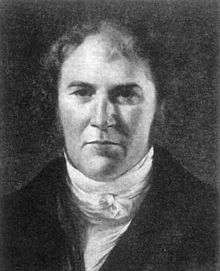Robert Adrain
Robert Adrain (30 September 1775 – 10 August 1843) was an Irish mathematician, whose career was spent in the USA. He was considered one of the most brilliant mathematical minds of the time in America, during a period when few academics conducted original research.[1] He is chiefly remembered for his formulation of the method of least squares.
Robert Adrain | |
|---|---|
 Robert Adrain | |
| Born | 30 September 1775 Carrickfergus, County Antrim, Ireland |
| Died | 10 August 1843 (aged 67) New Brunswick, New Jersey, US |
| Known for | Least squares method |
| Scientific career | |
| Fields | Diophantine algebra Statistics |
| Institutions | Queen's College/Rutgers Columbia College University of Pennsylvania |
Biography
He was born in Carrickfergus, County Antrim, Ireland, but left Ireland after being wounded in the failed uprising of the United Irishmen in 1798[2] and moved to Princeton, New Jersey. He taught mathematics at various schools in the United States. He was president of the York County Academy in York, Pennsylvania, from 1801 to 1805.
He is chiefly remembered for his formulation of the method of least squares, published in 1808. Adrain certainly did not know of the work of C.F. Gauss on least squares (published 1809), although it is possible that he had read A.M. Legendre's article on the topic (published 1806).
Adrain was an editor of and contributor to the Mathematical Correspondent, the first mathematical journal in the United States. Later he twice attempted to found his own journal, The Analyst, or, Mathematical Museum, but in both the 1808 and 1814 attempts it did not attract sufficient subscribers and quickly ceased publication. He was elected a Fellow of the American Academy of Arts and Sciences in 1813.[3] In 1825 he founded a somewhat more successful publication targeting a wider readership, The Mathematical Diary, which was published through 1832.[4]
Adrain, Gauss, and Legendre all motivated the method of least squares by the problem of reconciling disparate physical measurements; in the case of Gauss and Legendre, the measurements in question were astronomical, and in Adrain's case they were survey measurements.
Adrain was the father of Congressman Garnett B. Adrain.[5] Robert Adrain died in New Brunswick, New Jersey. He is commemorated by a blue plaque, unveiled at Carrickfergus by the Ulster History Circle.
References
- Who Was Who in America, Historical Volume, 1607–1896. Marquis Who's Who. 1967.
- https://archive.org/stream/newinternational01gilm#page/127/mode/1up
- "Book of Members, 1780–2010: Chapter A" (PDF). American Academy of Arts and Sciences. Retrieved 6 April 2011.
- Parshall, Karen Hunger; David E. Rowe (1994). The Emergence of the American Mathematical Research Community, 1876–1900. American Mathematical Society. pp. 43–44. ISBN 0-8218-9004-2.
- Wilson, J. G.; Fiske, J., eds. (1900). . Appletons' Cyclopædia of American Biography. New York: D. Appleton.
Sources
- Webb, Alfred (1878). . A Compendium of Irish Biography. Dublin: M. H. Gill & son – via Wikisource.
- Struik, D.J (1970). "Robert Adrain". Dictionary of Scientific Biography. 1. New York: Charles Scribner's Sons. pp. 65–66. ISBN 0-684-10114-9.
- Stigler, Stephen M. "Adrain, Robert". Oxford Dictionary of National Biography (online ed.). Oxford University Press. doi:10.1093/ref:odnb/172. (Subscription or UK public library membership required.)
- Attribution

Further reading
- Robert Adrain. "Research concerning the probabilities of the errors which happen in making observations, &c". The Analyst, or Mathematical Museum. Vol. I, Article XIV, pp 93–109. Philadelphia: William P. Farrand and Co., 1808.
- Brian Hayes. "Science on the Farther Shore". American Scientist, 90(6):499, 2002. (Article may be viewed at: http://www.americanscientist.org/.)
- Thomas Preveraud. « Vers des mathématiques américaines. Enseignements et éditions: de Robert Adrain à la genèse nationale d’une discipline (1800–1843). », université de Nantes, Centre François Viète.
- Stephen M. Stigler. "Mathematical statistics in the early States". Annals of Statistics, 6:239–265, 1978.
External links
| Wikimedia Commons has media related to Robert Adrain. |